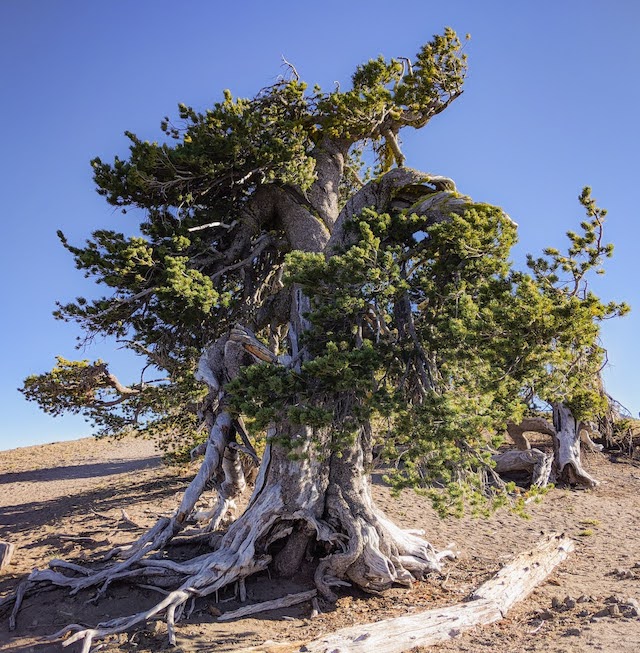
Breaking News: Whitebark Pine Listed as Threatened in U.S.

FOR IMMEDIATE RELEASE
Media Contact: Julee Shamhart, [email protected], (406) 925-9545
Whitebark Pine Listed as Threatened under the U.S. Endangered Species Act
Critical Protection Provided to an Ecologically Important Western High-Elevation Forest Tree
MISSOULA, Mont., Dec. 14, 2022 — In a highly anticipated decision, the U.S. Fish & Wildlife Service (USFWS) issued a final rule to list whitebark pine (Pinus albicaulis) as a threatened species under the Endangered Species Act of 1973 (ESA). This landmark listing establishes protections and conservation measures for whitebark pine across its U.S. range. Whitebark pine is the most widely distributed tree species to be listed under the ESA.
Whitebark pine inhabits over 80 million acres in western North America with approximately 70% of its distribution in the U.S. It ranges from 36 to 56 degrees latitude throughout the higher mountain ranges of the Pacific states and British Columbia, Canada, and throughout the Rocky Mountains from the Greater Yellowstone region north through the Canadian Rockies. Whitebark pine is listed as endangered in Canada under the Species at Risk Act and on The IUCN Red List of Threatened SpeciesTM, underscoring the urgent need to secure protections range wide.
The Whitebark Pine Ecosystem Foundation (WPEF), founded in 2001 by a concerned group of researchers and land managers, has tirelessly advocated for whitebark pine conservation and restoration. “We applaud the decision by the USFWS to list whitebark pine as threatened. It brings much-needed attention to the plight of this remarkable tree and builds further public support for the challenging restoration work ahead,” said David Neale, WPEF director and emeritus professor of plant sciences at the University of California, Davis.
Whitebark pine is a slow-growing, long-lived tree species that inhabits high-elevation forests up to 12,000 feet. The tree provides many ecosystem services, including critical wildlife habitat, re-establishing plant and animal communities after wildfire, and slowing snowmelt and regulating downstream waterflow. Its nutritious seeds are an important wildlife food for many birds and mammals, including the Clark’s nutcracker — a mountain bird that whitebark pine depends on for seed dispersal — and the threatened grizzly bear. Many outdoor enthusiasts value this unique tree, associated with some of the most iconic mountainous landscapes across public lands in the West, with its wind-sculpted, often-twisted growth forms. Indigenous peoples have traditional knowledge of whitebark pine and harvested its seeds as an important winter food.
Whitebark pine is declining rapidly throughout much of its range, particularly in the Northern Rockies, where some locations have experienced up to 90% tree mortality. It is primarily threatened by an introduced fungal disease (white pine blister rust) but also mountain pine beetle outbreaks and more frequent and severe wildfires, which are all amplified by climate change. “Whitebark pine is the center of an important web of life and provides valuable ecosystem services in western high-elevation forests. But it is facing an unprecedented convergence of lethal threats,” said Diana Tomback, WPEF policy and outreach coordinator and professor of integrative biology at the University of Colorado Denver.
The widespread decline in whitebark pine from multiple threats requires timely management intervention. Many restoration tools and management techniques exist that include planting disease-resistant seedlings, prescribed fire and forest thinning. With nearly 90% of whitebark pine’s range in the U.S. on federal lands, the listing also provides an outstanding opportunity to work across agencies to restore the species. “We have the tools and capability to make populations more resilient to these threats. Given the scale of this effort, we are approaching restoration both collaboratively and strategically,” said Tomback.
The USFWS listing decision will lead to a recovery plan coordinated across federal land management agencies. To aid in these efforts, WPEF and American Forests, in consultation with the U.S. Forest Service and other federal and tribal partners, have been developing the National Whitebark Pine Restoration Plan, which will uniquely position these agency partners to implement and fund the large-scale landscape restoration efforts required to recover this species. The plan will be released in 2023.

Image Credit: Quinn Lowrey. Grandmother Tree (whitebark pine, Pinus albicaulis) at Crater Lake National Park, Oregon. More information for the media and photo resources are available online in a media kit. A PDF version of this press release is also available for download.
About the Whitebark Pine Ecosystem Foundation
WPEF is a science-based, nonprofit organization dedicated to promoting the conservation and restoration of whitebark pine and other high-elevation, five-needle white pines in western North America through education and outreach, research and collaborations. Learn more about our work at whitebarkfound.org.

